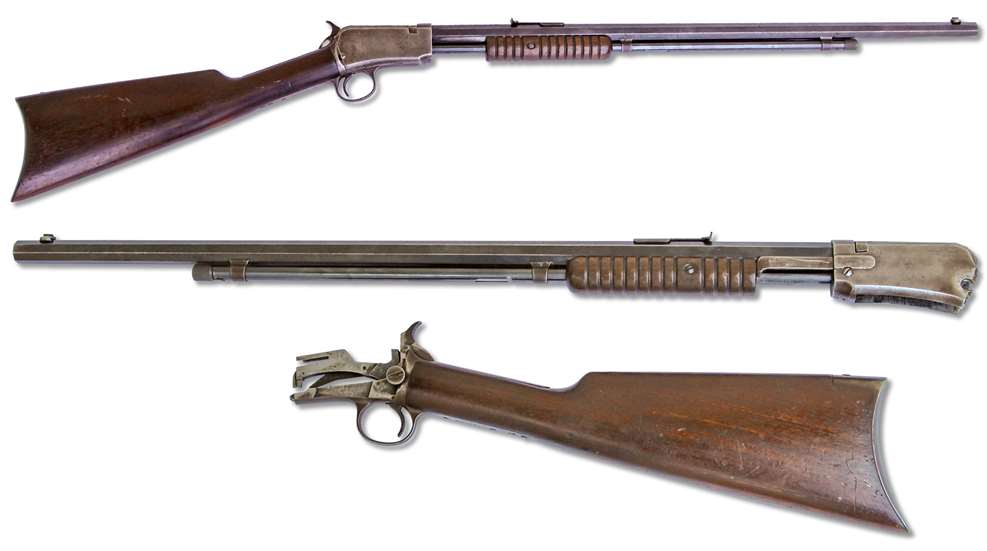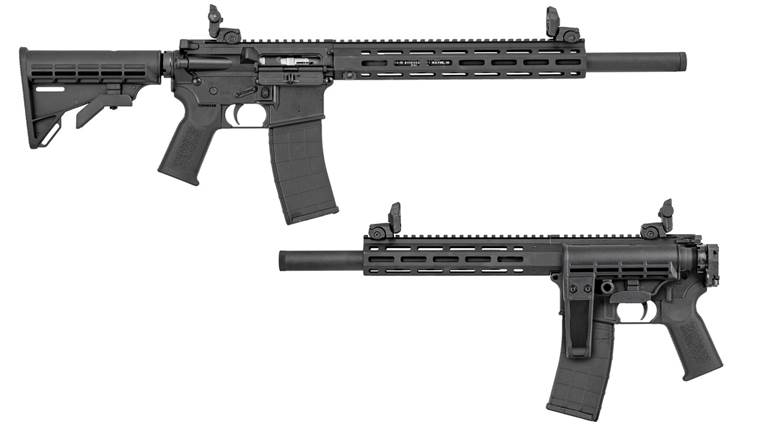
In 1884, after having entered into an alleged “gentleman’s agreement” in which Colt’s Patent Firearms would stop making its Colt-Burgess lever-action rifles and, in exchange, Winchester Repeating Arms would abandon its proposed plans to manufacture revolvers, Winchester’s executives were taken aback when Colt introduced its Lightning slide-action repeating rifle. Evidently, Colt had assumed this agreement only applied to lever-actions. In retaliation, T.G. Bennett, Winchester‘s vice president, called upon John and Matthew Browning to create a slide-action rifle that would be superior to the Colt product.
The Browning brothers succeeded by designing what was to become the most popular repeating rimfire rifle Winchester ever produced, the Model 1890 slide-action repeater, a slim, lightweight, .22 pump-action rifle with a 24" octagonal barrel. Introduced in November 1890, the Model 90 was brought out in three non-interchangeable chamberings: .22 Short (often referred to as “gallery guns,” as that’s where many of these rugged rifles were used); .22 Long; and the then-new .22 WRF (Winchester Rim Fire), a cartridge created especially for the Model 90 as a slightly more powerful version of the .22 Long Rifle. Interestingly, although the .22 Long Rifle had existed since 1887, it wasn’t offered as a catalogued chambering for the Model 90 until 1919.
The fact that the Model 90 was initially chambered for the harder-hitting .22 WRF, rather than the .22 Long Rifle, reflected the fact that, like many guns the Browning brothers invented, the Model 1890 was decidedly over-built. In fact, it was originally intended to chamber the same centerfire cartridges as Winchester’s lever-actions, but it was soon realized that the company would be competing against its own immensely successful Model 1873 and, to a lesser extent, the Model 1876. Thus, it was wisely decided to produce the Model 1890 strictly as a .22 rimfire, inasmuch as Winchester’s only other .22 rimfire was the Model 1873, which was not selling well and was losing out to the less expensive .22s of the day, such as the various single-shots produced by the J. Stevens Arms & Tool Co.
However, at $16, which included a separate brass cleaning rod, the Model 1890 pretty much had the rimfire repeating rifle market cornered. Massive twin locking lugs on either side of the bolt (concealed on First and Second models but visible on Third models) firmly anchored the action when it was closed. Loading was via a tube underneath the barrel. With a blued barrel and a bone-charcoal casehardened receiver, trigger and hammer—changed to a blued finish in 1901—the first 15,500 guns were solid-frame, but, after 1892, a takedown feature was added via a receiver-mounted knob that permitted separating the rifle into two sections. In 1919, around Serial No. 640,000, Winchester simplified the Model 1890 nomenclature to “Model 90.” Like most early Winchesters, the Model 90 could be ordered with pistol-grip stocks and fancy engraving, but such guns are rare. Black-lacquered stainless-steel barrels were offered from approximately 1927 to 1934, but proved to be unpopular—although they are a collectible variation today.
Ideal for small-game hunting, the fact that the Model 90 could also be “slam-fired” by holding the trigger back while rapidly working the pump added to its versatility for riddling tin cans and eradicating vermin. With approximately 849,000 rifles produced between 1890 and 1932, the Model 90 was finally replaced by the Winchester Model 62, which was able to handle .22 Short, Long and Long Rifle cartridges interchangeably.
This Third model, chambered in .22 Long Rifle, was made in 1919 and retains 70 percent of its original blued finish. As such, it is worth $1,500 to $2,000.
Gun: Winchester Model 90 – Third Model
Chambering: .22 Long Rifle
Serial No.: 620331
Manufactured: 1919 (first year of .22 LR chambering)
Condition: NRA Good (Modern Gun Standards)
Value: $1,500 to $2,000




































